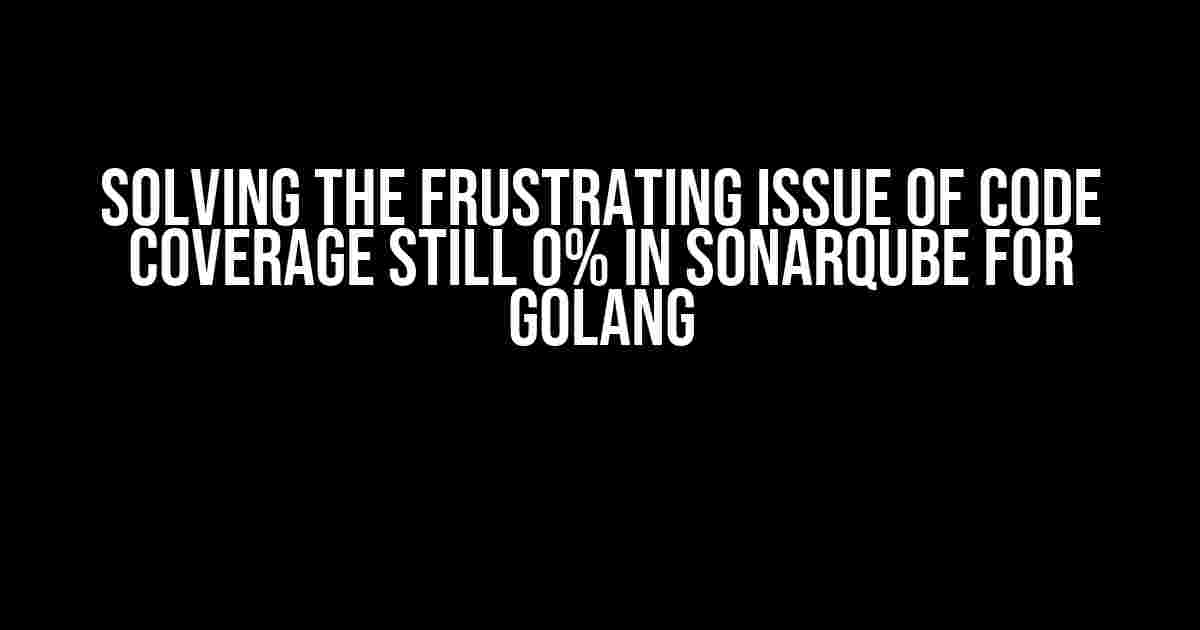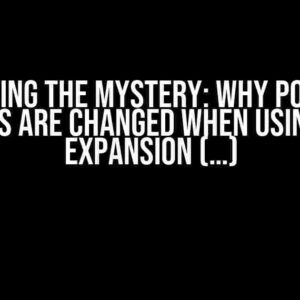Are you tired of seeing that dreaded 0% code coverage in SonarQube for your Golang project? You’re not alone! Many developers have faced this frustrating issue, but don’t worry, we’ve got you covered. In this comprehensive guide, we’ll walk you through the steps to resolve this problem and get accurate code coverage reporting in SonarQube.
What is Code Coverage, and Why is it Important?
Code coverage is a measure of how much of your code is executed during automated tests. It’s an essential metric for ensuring that your code is thoroughly tested and reliable. With code coverage, you can identify areas of your code that need more testing, reducing the risk of bugs and errors.
In SonarQube, code coverage is an integral part of the code analysis process. It provides a comprehensive view of your code’s health, helping you to identify vulnerabilities, bugs, and areas for improvement.
Why is Code Coverage still 0% in SonarQube for Golang?
There are several reasons why code coverage might still be 0% in SonarQube for your Golang project:
- Incorrect configuration of SonarQube
- Inadequate test coverage
- Issues with the Go test framework
- Incompatible versions of SonarQube and Golang
In the following sections, we’ll explore each of these reasons and provide solutions to resolve the issue.
Step 1: Verify SonarQube Configuration
To ensure accurate code coverage reporting, you need to configure SonarQube correctly. Here are the steps to follow:
- Log in to your SonarQube instance and navigate to the project settings.
- Click on the “Analysis” tab and select “Golang” as the language.
- In the “Test coverage” section, select “Go test” as the test framework.
- Make sure the “sonar.go.test.reportPaths” property is set to the correct path of your test report file.
- Save the changes and re-analyze your project.
sonar.go.test.reportPaths=report.out
In the above example, the test report file is named “report.out” and is located in the root directory of your project. Adjust the path accordingly based on your project structure.
Step 2: Improve Test Coverage
Inadequate test coverage is a common reason for 0% code coverage in SonarQube. To improve test coverage, follow these best practices:
- Write unit tests for individual functions and methods.
- Use mocking libraries to isolate dependencies and improve test efficiency.
- Implement integration tests to cover larger code scenarios.
- Use a testing framework like Ginkgo or Gocheck to simplify test writing.
Here’s an example of a simple unit test in Ginkgo:
func TestAddFunction(t *testing.T) {
g := NewWithT(t)
result := Add(2, 3)
g.Expect(result).To(Equal(5))
}
In this example, we’re testing the “Add” function using Ginkgo’s “Expect” method.
Step 3: Resolve Issues with the Go Test Framework
The Go test framework can sometimes cause issues with code coverage reporting. Here are some potential solutions:
- Use the “-cover” flag with the “go test” command to generate test coverage reports.
- Use a third-party tool like “go-acc” to collect test coverage data.
- Disable the ” go test -v” flag, which can interfere with code coverage reporting.
Here’s an example of using the “-cover” flag:
go test -cover -coverprofile=coverage.out
In this example, the test coverage data is written to a file named “coverage.out” in the current directory.
Step 4: Verify SonarQube and Golang Version Compatibility
Incompatible versions of SonarQube and Golang can cause issues with code coverage reporting. Here are the compatible versions:
| SonarQube Version | Golang Version |
|---|---|
| SonarQube 8.9+ | Golang 1.16+ |
| SonarQube 8.5-8.8 | Golang 1.14-1.15 |
| SonarQube 8.0-8.4 | Golang 1.13 |
Make sure you’re using a compatible version of SonarQube and Golang to avoid any compatibility issues.
Conclusion
Solving the issue of 0% code coverage in SonarQube for your Golang project requires a combination of correct configuration, adequate test coverage, and compatible versions of SonarQube and Golang. By following the steps outlined in this guide, you should be able to resolve the issue and get accurate code coverage reporting.
Remember, code coverage is an essential metric for ensuring the quality and reliability of your code. By prioritizing test coverage and using SonarQube to analyze your code, you can identify areas for improvement and deliver high-quality software products.
Happy coding!
Frequently Asked Question
Getting stuck with Code Coverage still showing 0% in SonarQube for Golang? Don’t worry, we’ve got you covered! Check out these frequently asked questions and their answers to get back on track.
Why is my code coverage still showing 0% in SonarQube for Golang?
This might be because you haven’t configured your test coverage properly. Make sure you’re using a supported test coverage tool like Gocov or Covermode, and that you’ve correctly configured the sonar-golang plugin to pick up the coverage reports.
How do I configure the sonar-golang plugin to pick up the coverage reports?
You need to set the `sonar.coverageReportPaths` property in your `sonar-project.properties` file to point to the location of your test coverage report file. For example, `sonar.coverageReportPaths=coverage.out`. This will tell SonarQube where to find the coverage report.
What format should my coverage report be in?
SonarQube supports several formats, including Cobertura, JaCoCo, and Generic Coverage. For Golang, you’ll typically want to use the Cobertura format. Make sure your test coverage tool is generating a report in one of these supported formats.
Do I need to run my tests and coverage reports separately?
No, you don’t need to! You can use tools like Gocov or Gotestsum to run your tests and generate coverage reports in a single step. These tools will take care of executing your tests and producing a coverage report in a format that SonarQube can understand.
I’ve done all of this, but my code coverage is still showing 0%. What’s going on?
Don’t worry, it’s frustrating when things don’t work as expected! Double-check that your test coverage report is being generated correctly and that the file path in `sonar.coverageReportPaths` is correct. Also, make sure that your SonarQube scanner is correctly configured to pick up the coverage report. If you’re still stuck, try checking the SonarQube logs for any errors or warnings that might help you troubleshoot the issue.


